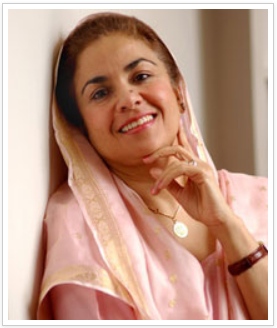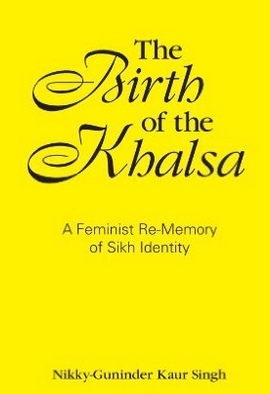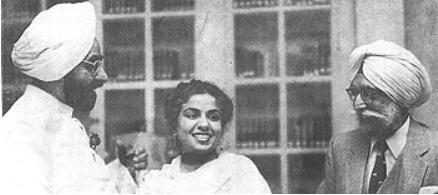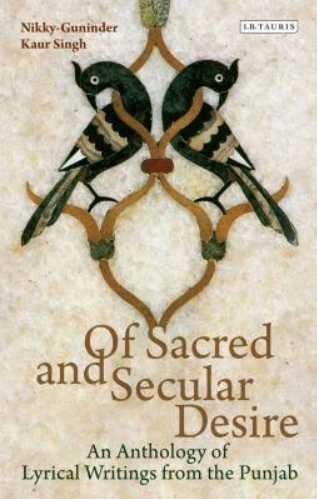Prof. Nikky Guninder Kaur Singh
 The Department of Historical Studies of Punjabi University (Patiala, Punjab), bestowed a Fellowship on Nikki Guninder Kaur Singh, Chair and Professor of Religion at the Department of Religious Studies, Colby College, Waterville, Maine, U.S.A.
The Department of Historical Studies of Punjabi University (Patiala, Punjab), bestowed a Fellowship on Nikki Guninder Kaur Singh, Chair and Professor of Religion at the Department of Religious Studies, Colby College, Waterville, Maine, U.S.A.
She also presented a lecture on the relevance of Guru Granth Sahib in the modern society at the University. She said historical scriptures were valuable in today's society.
She said Sikhism was a powerful medium of teaching right things in life and her main focus was to explain Sikhism to the West. She said many Americans were interested in Sikhsim. "I am currently working to translate Sikh religious works into English," she said.
Guninder stressed on the five themes that had vital contemporary relevance: Historical Reality (Guru Granth Ji Manio Pargat Guraa(n) Ki Deh); the Infinite One (Ik Oankar); egalitarian ethics (khatri Brahman sud vais updes cahu varna ko sajha); a magical planetarium: worlds beyond worlds (pataala paatal lakh aagaasa aagaas); a feminist text: the divine is both male and female (aapey purakh aapey hi nar).
Guninder's father, Prof. Harbans Singh (Editor, Encyclopaedia of Sikhism), had earlier taught at the same university in its Department of Religious Studies.
 Nikky was born in India, and went to Stuart Hall, a Girls' Preparatory School in the U.S.A.. She received her B.A. in Philosophy and Religion from Wellesley College, her M.A. from the University of Pennsylvania, and her Ph.D. from Temple University. She is currently the Crawford Family Professor at Colby College in Maine, U.S.A. Her interests focus on poetics and feminist issues.
Nikky was born in India, and went to Stuart Hall, a Girls' Preparatory School in the U.S.A.. She received her B.A. in Philosophy and Religion from Wellesley College, her M.A. from the University of Pennsylvania, and her Ph.D. from Temple University. She is currently the Crawford Family Professor at Colby College in Maine, U.S.A. Her interests focus on poetics and feminist issues.
Nikky Singh has published extensively in the field of Sikhism, including The Feminine Principle in the Sikh Vision of the Transcendent (Cambridge: Cambridge University Press, 1993), The Name of My Beloved: Verses of the Sikh Gurus (HarperCollins and Penguin), Metaphysics and Physics of the Guru Granth Sahib (Sterling). Her book on Sikhism was translated into Japanese. She has lectured widely in North America, England, France, India, and Singapore, and her views have been aired on television and radio in America, Canada, and India.
Her most recent publications incude The Birth of the Khalsa: A Feminist Re-Memory of Sikh Identity; and Cosmic Symphony: The Early & Later Poems of Bhai Vir Singh.
|


 Nikky-Guninder Kaur Singh was born in India, and went to Stuart Hall, a Girls' Preparatory School in the USA. She received her BA in Philosophy and Religion from Wellesley College, her MA from the University of Pennsylvania, and her PhD from Temple University. This photograph with the President of India, Giani Zail Singh, and her father (on her left) celebrates the launching of her first book on Sikh aesthetics. The image was taken at the Rashtrapati Bhavan (President's House), New Delhi, India.
Nikky-Guninder Kaur Singh was born in India, and went to Stuart Hall, a Girls' Preparatory School in the USA. She received her BA in Philosophy and Religion from Wellesley College, her MA from the University of Pennsylvania, and her PhD from Temple University. This photograph with the President of India, Giani Zail Singh, and her father (on her left) celebrates the launching of her first book on Sikh aesthetics. The image was taken at the Rashtrapati Bhavan (President's House), New Delhi, India. She is the Crawford Family Professor at Colby College in Maine, USA. Her interests focus on poetics and feminist issues. Nikky Singh has published extensively in the field of Sikhism, including The Feminine Principle in the Sikh Vision of the Transcendent (Cambridge: Cambridge University Press, 1993), The Name of My Beloved: Verses of the Sikh Gurus (HarperCollins and Penguin), Metaphysics and Physics of the Guru Granth Sahib (Sterling). Her book on Sikhism was translated into Japanese. She has lectured widely in North America, England, France, India, and Singapore, and her views have been aired on television and radio in America, Canada, Bangladesh, Australia, Ireland and India.
She is the Crawford Family Professor at Colby College in Maine, USA. Her interests focus on poetics and feminist issues. Nikky Singh has published extensively in the field of Sikhism, including The Feminine Principle in the Sikh Vision of the Transcendent (Cambridge: Cambridge University Press, 1993), The Name of My Beloved: Verses of the Sikh Gurus (HarperCollins and Penguin), Metaphysics and Physics of the Guru Granth Sahib (Sterling). Her book on Sikhism was translated into Japanese. She has lectured widely in North America, England, France, India, and Singapore, and her views have been aired on television and radio in America, Canada, Bangladesh, Australia, Ireland and India.